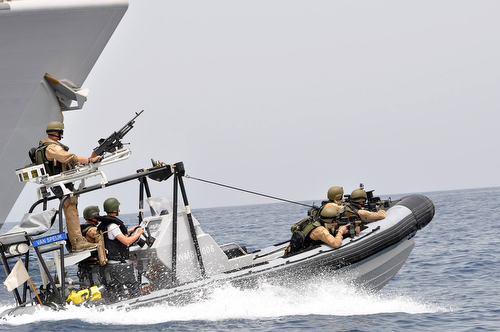Neuausrichtung auf Niederländisch
Auf die niederländischen Streitkräfte kommt eine tiefgreifende Umstrukturierung zu. In großen Zügen hat sie Verteidigungsministerin Jeanine Hennis-Plasschaert am (heutigen) Dienstag dem Parlament mitgeteilt. Kernaussage: Die Truppe soll kleiner werden, aber weiterhin auch für weltweite Einsätze bereitstehen.
In den grundsätzlichen Aussagen der Ministerin habe ich zwar keine Zahlen zum Streitkräfteumfang gefunden, aber interessante Details wie den Verzicht auf das Joint Support Ship und den Plan, die Luchtmobiele Brigade in die deutsche Division Schnelle Kräfte zu integrieren (was nach der Vereinbarung der niederländischen Ministerin mit ihrem deutschen Kollegen Thomas de Maizière im Mai weitgehend klar war). An der Beschaffung des neuen Joint Strike Fighters F-35 halten die Niederlande fest, das Air Policing soll gemeinsam mit Belgien betrieben werden.
Die Aussagen von Hennis-Plaesschaert auf der offiziellen Webseite als Video, der Plan zur Neuausrichtung zum Nachlesen auf Niederländisch (darin sind auch die Zahlen zum Haushalt enthalten) – vor allem aber, der Einfachheit halber, eine englische Zusammenfassung:
The paper entitled “In the interest of the Netherlands” sets out important decisions concerning the future of the Netherlands armed forces. The Netherlands government has opted for an armed forces that is sustainable, both from an operational and a financial point of view. This will ensure that the armed forces is future-proof and financially solid.
Having a high-quality armed forces is in the interests of the Netherlands and its allies. The threats and risks we face, both now and in the future, are diffuse. Having the ability to exercise escalation dominance is important—on land, at sea and in the air. In the future, the Netherlands armed forces will still be able to conduct all types of operations, both at home and abroad. Our participation in missions will, however, sometimes have to be limited to shorter periods of time than was previously possible.
Within the available budget, there will also be a strong focus on innovation and new investments. Examples are the replacement of the F-16 with the F-35 and the accelerated formation of the Cyber Command. We also put priority on intensifying our cooperation with international partners and national, non-military authorities. This will enhance the armed forces’ ability to take action.
In order to ensure that our finances are kept in order, the paper incorporates various reorganisations as well as a number of government-wide cutbacks. Given the importance we attach to innovation and high-tech materiel, the ministry of defence will continue to work towards bringing its annual investment percentage back up to 20 percent.
The combination of our current basic and niche capabilities forms a solid basis on which to build. Maintaining military niche capabilities is of great importance to the Netherlands, as there are shortfalls in certain niche capabilities within the EU and NATO. The niche capabilities to be maintained include the Patriot units, the submarine service and the German-Netherlands Corps headquarters.
The report also emphasises the role of the ministry of defence in the area of national security. One-third of our total military capacity is deployed on a daily basis for ensuring security in the Netherlands. This includes coastguard tasks, explosive ordnance disposal and specialist assistance to judicial authorities in tracking down and rounding up criminal networks.
There are three criteria to take into account when making choices between capabilities: usability, adaptability and durability. Firstly, the armed forces must be able to achieve the required results in diverse circumstances and in various types of missions. This requires a sound balance between combat units and support units. In addition, the capabilities must be adaptable to rapidly changing (operational) circumstances. The greater the adaptability, the more extensive are our deployment options. Thirdly, capabilities must continue to be deployable in the future under different circumstances.
In the past few years, the air force has proven once again to be an indispensable element of the armed forces. With the F-35, the ministry of defence has made a well-considered choice for a high-tech, future-oriented air force. From a military operational perspective, it offers the greatest number of options. It has been decided that the replacement of the F-16 will be carried out entirely within the previously reserved investment budget and the current operating budget. This will prevent budget displacement effects, which would sooner or later come at the cost of other capabilities. The deployability of our helicopters will be improved in the coming years by increasing the number of flying hours. Extra funds will be made available for that purpose. With regard to transport aircraft, the ministry of defence’s long-term aim is for full international integration of its air transport capability in order to create the economies of scale necessary in the long term for effective operations.
The direction in which the Royal Netherlands Navy has been developing and its close cooperation with the Belgian navy will remain unchanged. The same applies to our surface fleet. The Air Defence and Command (ADC) frigates are among the most modern in the world. Due to their specific characteristics, the Walrus-class submarines will continue to be a relevant niche capability for NATO and the EU. The two Landing Platform Docks with embarked marines will form the core of our sea-based maritime combat power. However, the Joint Support Ship, which is currently under construction, will not be commissioned. Instead, the ministry of defence will procure a more basic and less expensive supply ship. The 32nd Marine Company in Aruba is to be disbanded. In future, the tasks in Aruba will be carried out by rotating units of the Royal Netherlands Navy and the Royal Netherlands Army, as is already the case in Curaçao.
The army will continue to develop into a versatile, modular organisation. In future, the army will have mechanised, motorised and airmobile battalions at its disposal. A mechanised battalion is built around the modern CV90 tracked vehicle, while a motorised battalion is built around the Bushmaster wheeled vehicle and the open-top Mercedes Benz 280CDI. The 45th armoured infantry battalion is to be disbanded, leaving a total of eight infantry battalions, six of which are part of the Royal Netherlands Army. The airmobile brigade will continue to be an important initial-entry capability for the army, also when operating in combination with the Commando Corps. Our cooperation with the German army will be further enhanced by integrating the airmobile brigade with the Division Schnelle Kräfte. The three brigade headquarters in Havelte, Oirschot and Schaarsbergen will continue to enable the army to integrate individual modules into a national battalion task force (such as Task Force Uruzgan), as well as in an international context (such as a NATO Response Force or an EU Battle Group). The German-Netherlands Corps headquarters in Münster will develop further into a rapidly deployable joint headquarters, capable of directing combined land-based and air-based operations. A large part of the army consists of scarce ‘enablers’—such as combat support units and combat service support units—which work for all the operational commands.
And finally, the tasks of the Royal Netherlands Marechaussee will remain unchanged but will be carried out differently. The territorial division of capabilities will no longer be a dominant factor. Instead, a mobile and flexible approach will be adopted, based on information-driven operations. Due to the measures being taken by the operational commands and a further reduction of the number of locations, there will be fewer military police tasks.
This set of measures will allow the Netherlands armed forces to fulfill our national and international responsibilities, both now and in the future.
Nachtrag: F-35-Hersteller Lockheed ist natürlich elektrisiert.
(Foto: Boarding Team der Fregatte HNLMS Van Speijk im NATO-Antipiraterieeinsatz Ocean Shield vor Somalia – Foto NATO via Facebook)




@NMWC
Na ich hab auch auf Minenböcken gelernt und unterstütze ja ihren Spezialisierungsgedanken an sich durchaus ;)
Aber beim Gegenlesen des Threads sind wir irgendwann von möglicher Beschaffung eines NED JSS hin zur grundsätzlichen Sinnhaftigkeit DEU JSS gesteuert. Als Nutzer müsst ich das fast trennen ;) – also die Frage „macht ein JSS überhaupt Sinn?“ Und die Frage „welches?“
Ich teile ja ihre Bedenken was Kosten und Aufwand betrifft, scheue sie aber nicht, vorallem da ich persönlich die Kosten/Nutzen Analyse im kompletten Einsatzspektrum (national/multinational) sehen würde.
Etwas multinational abbilden zu können heisst auch immer das (zumindest die Teile) der Fähigkeit ja auch irgendwo national abgebildet werden müssen. Jetzt kann man dem logischen Spezialisierungsansatz folgen – wie sie – und bekommt am Ende die wohl einsatstärkste Abbildung der Fähigkeit – wenn alle Teile mitmachen….
Und das sollte man auch in Anbetracht der jüngeren Vergangenheit wohl mitbedenken:
Ich hab 3 Töpfe (Länder). Nch dem Spezialisierungskonzept verteil ich Nahrung (Teilbefähigung 1), Wasser (TBF2) und Luft (TBF3) auf jeweils einen (den spezialisierten) Topf.
Funktioniert also eben nur wenn ich alle Töpfe dabei hab ;)
Und auch wenn ich grad merke, das ich unbewusst zum Verteidiger von „Breite vor Tiefe“ werde und es mir einen kalten Schauer über den Rücken jagt – so ist auch irgendwas dran ;)
Ich schließ mal den Kreis zum Beginn.
JSS und amphibische Anfangsoperationen hin oder her.
Wenn man in die große Runde der NATO- und EU-Staaten schaut, dann hat niemand mehr den Willen, das Geld, die Streitkräfte, die Polizisten, Entwicklungshelfer, Juristen und vorallem die Geduld für eine Stabilisierungsoperation mit unfriedlichem Anteil (a.k.a. COIN).
Für politisch noch Anspruchvolleres, wie Anfangsoperationen, sehe ich da noch weniger Bedarf. Zumal danach ne StabOp folgt („if you break it, you own it“).
Vielleicht ist auch dies ein Grund der Niederländer auf ein JSS zu verzichten?
Nach meinem Eindruck begrenzt sich die Rolle westlicher Landstreitkräfte immer mehr auf Ausbildungsunterstützung, MilEvakOp, SpezOp und begrenzte Bündnisverteidigung (konventionelle Abschreckung). Selbst in den USA sind derlei Stimmen sehr einflussreich (siehe: http://breakingdefense.com/2013/09/13/vcjcs-winnefeld-tells-army-to-forget-long-land-wars-congress-get-out-of-our-way/).
Es ist auch bei uns Zeit für ein ehrliches Level of Ambition.
Ehrlichkeit der Politik: was wollen wir wirklich?
Ehrlichkeit der Bundeswehr: was können wir wirklich.
Aber das ist wohl zu viel verlangt.
Heute mal was aus der Rubrik „der Dativ ist dem Genitiv sein Tod“:
Zitat: “ interessante Details wie den Verzicht auf das Joint Support Ship und DEN Plan, die Luchtmobiele Brigade in die deutsche Division Schnelle Kräfte zu integrieren“.
Das ist etwas missverständlich ausgedrückt : Verzicht auf das Schiff UND auf den Plan, oder sind der Verzicht auf das Schiff sowie der Plan der Integration zwei getrennte Sachen…..
Nach Auswertung der Originaldokumente wird meiner Meinung nach wohl auf das Schiff verzichtet, aber nicht auf den Plan, die LB in die DSK zu integrieren.
D.h. gemeint ist “ interessante Details wie den Verzicht auf das Joint Support Ship und DER Plan, die Luchtmobiele Brigade in die deutsche Division Schnelle Kräfte zu integrieren“.
Gruss vom Oberlehrer und Hilfsgermanisten